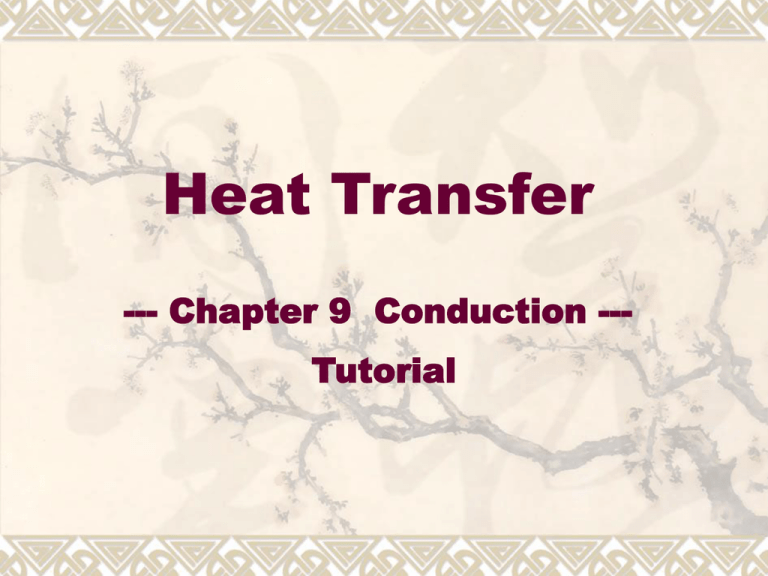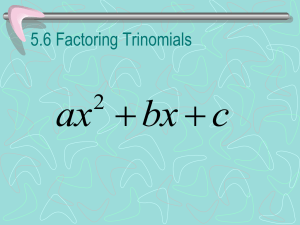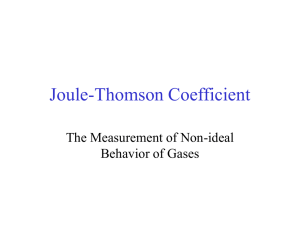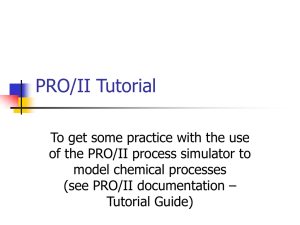工程热力学与传热学(双语)第9章习题课
advertisement

Heat Transfer --- Chapter 9 Conduction --Tutorial 傅里叶定律和导热微分方程的应用 习题课 1. 如图所示的墙壁,其导热系数为50 W/(m.K), 厚度为50mm,在稳态情况下墙壁内一维温度 分布为 t = 200 – 2000 x2 。式中x 的单位为m。 t 试求 (1)墙壁两侧表面的热流密度; 50W /(m.K ) 2 t 200 2000 x (2)壁内单位体积的内热源生成热。 50 mm 0 δ x 习题课 一维稳态导热 — 平板 2. 有一锅炉围墙由三层平壁组成,内层是厚度δ1=0.23m, λ1=0.63W/(m.K) 的耐火粘土砖;外层是厚度δ3=0.25m, λ3=0.56W/(m.K)的红砖层;两层中间填以厚度δ2=0.1m, λ2=0.08 W/(m.K)的珍珠岩材料。炉墙内侧与温度为 tf1=520℃的烟气接触,其表面传热系数h1=35W/(m2.K), 炉墙外侧空气温度tf2=22℃,空气侧表面传热系数 h2=15W/(m2.K)。 试求(1)通过该炉墙单位面积的散热损失; (2)炉墙内外表面温度及层与层交界面的温度; (3)画出炉墙内的温度分布曲线。 习题课 一维稳态导热 — 平板 3. 一建筑物墙壁由如图所示的空心砖砌成,空心砖尺寸 300mm×300mm×300mm。设该混凝土导热系数为 0.8W/(m.K),空气当量导热系数为0.28W/(m.K)。设温度 只沿墙壁厚度X方向发生变化,室内温度为25℃,表面传 热系数为10W/(m2.K),室外空气温度为 -10℃,表面传热 系数为20W/(m2.K)。 求通过每块砖的导热量。 2 h1 10W /(m .K ) t f 1 25C t f1 h1 75mm 75mm 75mm h2 20W /(m2 .K ) t f 2 10C 75mm 0 t f2 h2 x 习题课 一维稳态导热 — 圆筒壁 4. 外径5cm的不锈钢管,外面包扎着厚度为6.4mm 的石棉隔热层,导热系数为0.166W/(m.K), 再外面包扎着厚度为2.5mm的玻璃纤维隔热层, 导热系数为0.0485W/(m.K)。不锈钢管外壁温度 为315℃,隔热层外表面温度为38℃。 试计算石棉-玻璃纤维交界面的温度。 习题课 一维稳态导热 5. 蒸汽管道的外直径d1=30mm,准备包两层厚度 都是15mm的不同材料的热绝缘层。a种材料的 导热系数λa = 0.04W/(m.K),b 种材料的导热 系数λb= 0.1W/(m.K)。若温差一定。 试问从减少热损失的观点看下列两种方案: (1)a在里层,b在外层; (2)b在里层,a在外层。哪一种好,为什么? 习题课 变导热系数和变截面稳态导热 6. 一高为30cm铝制圆锥台,顶面直径为8.2cm, 底面直径为13cm;底面和顶面温度各自均匀且 恒定,分别为520℃和120℃,侧面(曲面)绝 热。试确定通过此台的导热量(铝的导热系数 取为100W/(m.K)。 x 8.2cm r dx x 13cm H=30cm 习题课 变导热系数和变截面稳态导热 7. 图中所示为纯铝制作的圆锥形截面。其圆形截面直径为 D=ax1/2,其中a=0.5m1/2。小端位于x1=25mm处,大端 位于x2=125mm处,端部温度分别为T1=600K和T2=400K, 周侧面隔热良好。 (1)作一维假定,推导用符号形式表示的温度分布T(x) 的表示式,画出温度分布的示意图。 (2)计算传热热流量Q。 T2=400k T1=600k D=ax1/2 T x1 a=0.51/2 x2 x 习题课 一维非稳态热传导 8. 初始温度为30℃,壁厚为9mm的火箭发动机喷管,外壁 绝热,内壁与温度为1750℃的高温燃气接触,燃气与壁面 间的表面传热系数为1950W/(m2.K)。假定喷管壁可作为 一维无限大平壁处理,材料物性如下:ρ=8400kg/m3, c=560J/(kg.K),λ=24.6W/(m.K)。试确定 (1)为使喷管材料不超过材料允许温度(1000℃)而能 允许的运行时间; (2)在允许时间的终了时刻,壁面中的平均温度梯度与 最大温度梯度。 习题课 集总热容系统 9. 用热电偶测量气罐中气体的温度。热电偶的初始温度 为 20℃,与气体表面的表面传热系数为10W/(m2.K)。 热电偶近似为球形,直径为0.2mm。 试计算热电偶插入10s后,其过余温度为初始过余温度 的百分之几?要使热电偶过余温度不大于初始过余温度 的1%,至少需要多长时间? 已知热电偶焊丝的λ= 67W/(m.K),ρ=7310kg/m3, c=228J/(kg.K)。 习题课 集总热容系统 10. 一直径为0.5mm的热电偶,其材料的密度ρ= 8930kg/m3, 比热c= 400J/(kg.K)。初始温度为25℃,被突然放于表面 传热系数为95 W/(m2.K),温度为120℃的气流中。 试问热电偶的过余温度为初始过余温度的1%及0.1% 时 需要多少时间?这时热电偶指示的温度是多少? Tutorial One-dimensional steady state heat-conduction 11. A large window glass 0.5cm thick [λ=0.78W/(m.℃) ] is exposed to warm air at 25℃ over its inner surface, and the heat transfer coefficient for the inside air is 15W/(m2.K). The outside air is -15℃, and the heat transfer coefficient associated with the outside surface is 50W/(m2.K). Determine the temp of the inner and outer surface of the glass. Tutorial One-dimensional steady state heat-conduction 12. A steel tube[λ=15W/(m.℃)] of outside diameter 7.6cm and thickness 1.3cm is covered with an insulation material [λ=0.2W/(m.℃)] of thickness 2cm. A hot gas at 320℃ with a heat transfer coefficient of 200W/(m2.K) flows inside the tube. The outer surface of the insulation is exposed to cooler air at 20℃ with a heat transfer coefficient of 50W/(m2.K) 。Calculate (1) the heat loss from the tube to the air for a 5-m length of the tube. (2) the temp drops due to the thermal resistances of the hot gas flow, the steel tube, the insulation layer, and the outside air. Tutorial One-dimensional steady state heat-conduction 13. A Steam pipe with an outside radius of 4cm is covered with a layer of asbestos insulation [λ=0.15W/(m.℃) ] 1cm thick, which is in turn covered with fiberglass insulation [λ=0.05W/(m.℃) ] 3cm thick. The outside surface of the steam pipe is at a temp of 330℃, and the outside surface of the fiberglass insulation is at 30℃. Determine the heat transfer rate per meter length of the pipe and the interface temp between the asbestos and the fiberglass insulation. Tutorial One-Dimensional Unsteady State Conduction Problem 14. A steel plate [a=1.2×10-5m2/s,λ=43W/(m.℃), cp=465J/(kg.℃) , ρ=7833kg/m3] of thickness 10cm, initially at a uniform temp of 240℃, is suddenly immersed in an oil bath at 40℃. The convection heat transfer coefficient between the fluid and the surface is 600W/(m2.℃). (a) How long will it take for the center-plane to cool to 100℃? (b) What is the temp at a depth 3cm from the outer surface? (c) Calculate the energy removed from the plate during this time . Lumped system analysis Tutorial 15. Using lumped system analysis, determine the time required for a solid steel ball of radius R=2.5cm, λ=54W/(m.℃),ρ=7833kg/m3, and c=0.465kJ/(kg.℃) to cool from 850℃ to 250℃ if it is exposed to an air stream at 50℃ having a heat transfer coefficient h=100W/(m2.℃). Lumped system analysis Tutorial 16. A Large aluminum plate [ λ=204W/(m.℃), ρ=2702kg/m3, and c=0.896kJ/(kg.℃) of thickness L=0.1m, that is initially at a uniform temperature of 250℃ is cooled by exposing it to an air stream at temperature 50℃ . Using lumped system analysis, determine the time required to cool the aluminum plate to 100℃ if the heat transfer coefficient between the air stream and the plate surface is h=80W/(m2.℃). Lumped system analysis Tutorial 17. A 6-cm-diameter steel ball [λ=61W/(m.℃), ρ=7865kg/m3, and c=0.46kJ/(kg.℃) is at a temperature of 800℃. It is to be hardened by suddenly dropping it into an oil bath at a temperature of 50℃. If the quenching occurs when the ball reaches a temperature of 100℃ and the heat transfer coefficient between the oil and the sphere is 500W/m2.℃, determine how long the ball should be kept in the oil bath. If 100 balls are to be quenched per minute, determine the rate at which heat must be removed from the oil bath in order to maintain the bath temperature at 50℃. Lumped system analysis Tutorial 18. A thermocouple is to be used to measure the temperature in a gas stream. The junction is approximated as a sphere with thermal conductivity of 25W/(m.℃), density of 9000kg/m3, and specific heat of 0.35kJ/(kg.℃). The heat transfer coefficient between the junction and the gas is 250W/(m2.℃). Calculate the diameter of the junction if the thermocouple should measure 95 percent of the applied temperature difference in 3s. Lumped system analysis Tutorial 19. The temperature of a gas steam is to be measured by a thermocouple whose junction can be approximated as a 1-mm-diameter sphere, The properties of the junction are λ=35W/(m.℃), ρ=8500kg/m3, and cp=320kJ/(kg.℃), and the convection heat transfer coefficient between the junction and the gas is h=210 W/(m2.℃). Determine how long it will take for the thermocouple to read 99 percent of the initial temperature difference.











